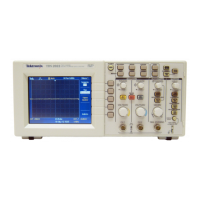Reference
Measure
Push the Measure button to access automatic measurements. There are sixteen
types of measurements available. You can display up t o five at a time.
Push the top option button t o display the Measure 1 Menu. You can choose the
channel on which to take a measurement in the Source option. You can choose the
type of measurement to take in the Type option. Push the Back option button to
return to the Measure Menu and display the selected measurements.
Key Po ints
Taking Mea
surements. Youcandisplayuptofive automatic measurements at a
time. The w aveform channel must be on (displayed) to make a measurement.
Automate
d measurements cannot be taken on reference waveforms, or while
using XY or scan mode. The measurements update about two times per second.
Measurement type Definition
Freq
Calculates the frequency of the waveform by measuring the first cycle
Period
Calculates the time of the first cyc le
Mean
Calculates the arithmetic mean amplitude over the entire record
Pk-Pk
Calculates the absolute difference between the maximum and minimum peaks of the entire
waveform
Cyc RMS Calculates a true RMS measurement of the first complete cycle of the waveform
RMS Calculates a true RMS measurement for all 2,500 samples from one frame of the waveform data
Cursor RMS Calculates a true RMS measurement of the waveform data from the selected starting to the ending
point
Min
Examines the entire 2500 point waveform record and displays the minimum value
Max
Examines the entire 2500 point waveform record and displays the m aximum value
Rise Time
Measures the time between 10% and 90% of the first rising edge of the w aveform
Fall Time
Measures the time between 90% and 10% of the first falling edge of the w aveform
Pos Width
Measures the time between the first rising edge and the next falling edge at the waveform 50% level
Neg Width
Measures the time between the first falling edge and the next rising edge at the waveform 50% level
Duty Cyc Measures the ratio of the positiv e pulse duration to the whole cycle
Phase
Calculates the phase angle difference of signals from two different channels, using the rising edge
of the first signal compared to the rising edge of the second signal
Delay
Calculates the time difference from two different channels using the rising edge of the first signal
compared to the rising edge of the second signal.
None Does not take any measurement
TDS2000C and TDS1000C-EDU Series Oscilloscope User Manual 89
